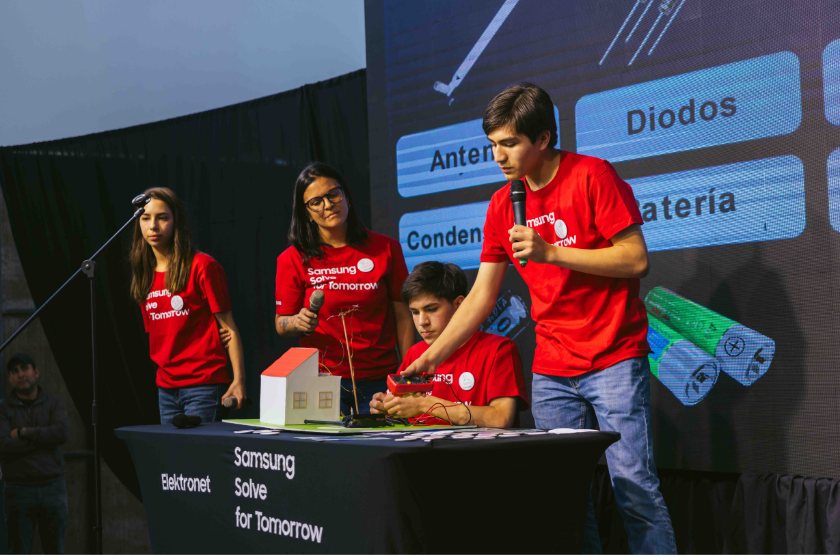Can you imagine using an Internet system to generate electricity? It sounds like something out of a science fiction movie, but it was the basis of the “Elektronet” project, a finalist in Solve for Tomorrow Chile, in 2023. The proposal aimed to be a solution to the lack of electricity, to bring it to where there is none, being a more economical option for the population; since in the country, one in four households find the expense of this essential service excessive, according to the Energy Poverty Network.
Teacher Natalia Navarro Cabello was the project mediator. She teaches Chemistry and Natural Sciences and is also in charge of the Science Department and all research projects. Since 2021, when she arrived at the school, the institution has been working with project-based learning considering Innovation and the areas of Science, Technology, Engineering and Mathematics (STEM). In March, at the beginning of each school year, the institution holds a call to form groups for these projects. Students join according to their affinities.
The team members were in their first and second year of secondary school (there are four in total, with whom compulsory schooling ends). “The first step was to investigate their environment based on observation; to see what local problems could be helped with a project,” says the teacher. “We started by carrying out a group research process where they began to ground their ideas and evaluate what would have the greatest impact. It is essential to have empathy at this stage,” she highlights.
The difficulties of a student inspire the project
The Santa Cruz de Unco School is a small school, with two classes of 20 to 30 students. Many of its students come from the towns around Santa Cruz city, where the economy is focused on agriculture and where access to energy is scarce for the population. There are still 24,556 homes without electricity, according to RedPe & Generadoras Chile.
“I had a student who found it extremely difficult to study during the pandemic. She was already in college and received a SIM card and a tablet, but the problem was how to connect. In the area where she lived, there was no electricity. Although there were around 50 families with solar panels, this device only charged one battery and lasted about six hours a day,” the educator recalls. According to her story, this energy was not enough and was mainly distributed to supply refrigerators and a single cell phone for the community.
“First they thought of a super-complex answer to this problem. They considered generating energy from different ionic methodologies,” explains Cabello. That is, from a chemical bond based on the electrostatic attraction of oppositely charged ions.
They embarked on intensive research, looking at several possibilities, but when they looked at the local context, they changed their minds: “They realized that electromagnetic waves from Wi-Fi systems were being discarded and could generate energy,” she says.
The team then analyzed data and looked for strategies used in other countries and came up with a novel proposal. “The prototype was a small box where we stored these electromagnetic waves using a very simple antenna. From it, we had a system that rectified the waves to obtain energy,” she describes.
But, according to the teacher, there are several types of waves and that is why they had to do many tests for approximately four months, to see which type worked best, stored more energy or lasted longer: “We had full wave and half wave. We plugged in a cell phone or a tablet and saw how long it would take to charge. Finally, we understood that the half wave was much better.”
Basically, the process starts with an antenna that captures radio frequency electromagnetic waves emitted by the Wi-Fi system. These are received in alternating current and, with diode bridges, it is possible to convert them into direct current, which is used to generate the electric charge. The capacitor stores the charge and the resistor reduces the electric flow. The Protoboard is a test board that serves to make the whole process work well.
Compared to other energy sources, “Elektronet” is non-invasive, scalable and replicable, cheap and accessible, allows 24/7 energy storage and emits zero greenhouse gasses.

Autonomy and alliances to put dreams into practice
For the educator, starting from a reflection and arriving at the result they achieved was very gratifying and only demonstrates the capacity that young people have when they are trusted.
I think I have to be just the guide of the process. The ideas have to come from the students. We had teachers and parents who did not believe that this project could become a reality. But I told them: everything can be done, if we look for strategies and alternatives, she says.
Partnerships were important for the success of the project. The Chilean Ministry of Science made the connection between the team and an Electrical Engineer, who helped provide a second opinion and greater technical knowledge. “Solve for Tomorrow’s mentoring was also key. They always help you with something. At first, it makes it easier for you to understand some actions. In the end, they even help with how to prepare the pitch,” believes the teacher.
The students were still motivated to continue the project, starting with the process of patenting the idea and then perfecting the prototype, testing it on other larger scales.




